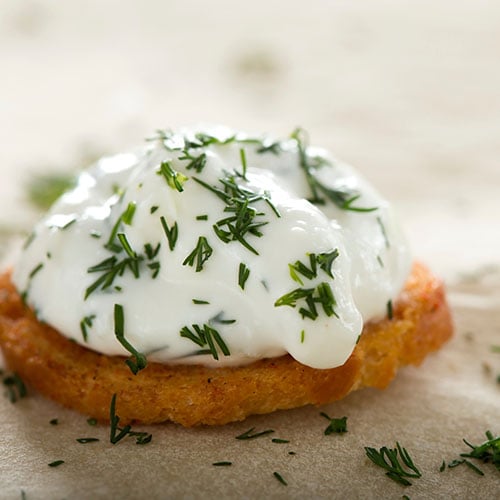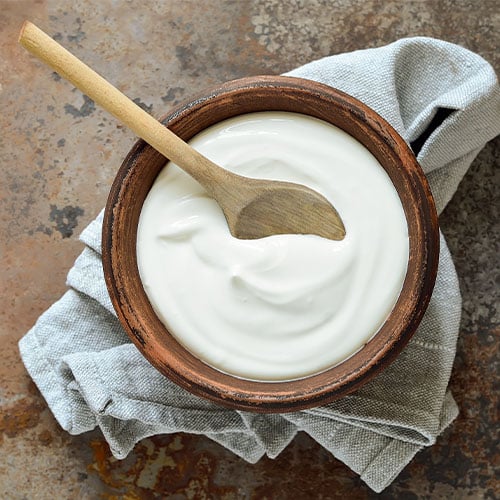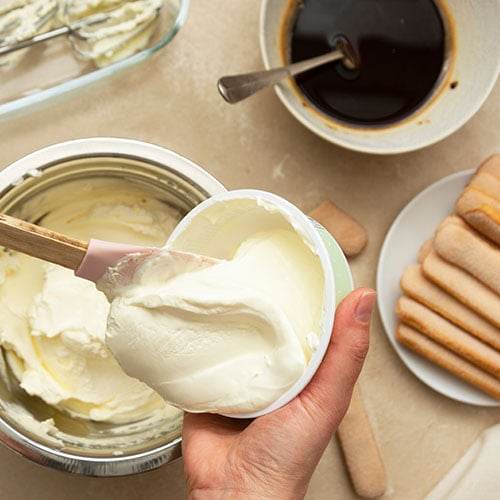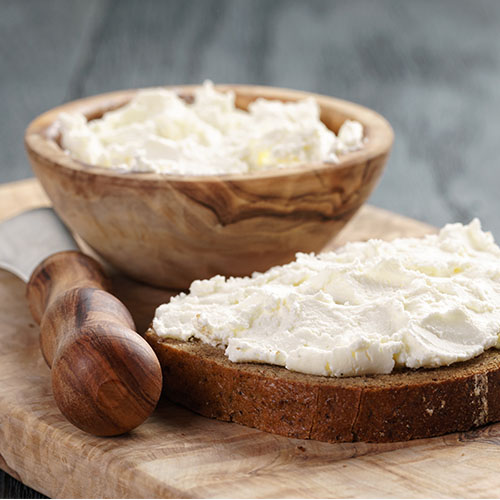Differences between Creme Fraiche, Sour Cream, Mascarpone, and Cream Cheese
Creme fraiche, sour cream, mascarpone, and cream cheese add a rich, velvety consistency and flavor to your culinary creations. These versatile ingredients can be used to cool down spicy dishes, for cooking, or in baking applications. While these creamy ingredients may appear similar at first glance, each one brings a unique taste and texture to the table. Understanding the differences between them will help you choose the right option for your recipe. When done properly, you can substitute them for each other without altering the flavor and consistency of your recipe.
- 1. Creme Fraiche
- 2. Sour Cream
- 3. Mascarpone
- 4. Cream Cheese
What Is Creme Fraiche?

Creme fraiche is a French-style cultured cream with a rich and velvety texture and a slightly tangy and nutty flavor profile. It's made by combining heavy cream with a culture of bacteria. Its fat content is typically around 30-40%, giving it a luxurious mouthfeel and creamy consistency. Its high-fat content also allows chefs to whip it into soft peaks, making it a popular choice for desserts and pastry fillings.
Creme fraiche is used in both cooking and baking. It can be added to pasta sauces, soups, and dressings to provide a rich and creamy base, or used as a topping for fresh fruit, desserts, or even savory dishes like baked potatoes or tacos. Its tangy flavor can help balance the sweetness of desserts or add a depth of flavor to savory dishes. Creme fraiche must be refrigerated at all times to maintain its freshness and prevent spoilage. It has a relatively short shelf life compared to other dairy products, so use it within a week or two of opening.
What Is the Difference between Creme Fraiche and Sour Cream?
Sour cream is cream that has been fermented with a culture of lactic acid bacteria. Creme fraiche is traditionally made from unpasteurized cream, where fermentation bacteria are naturally present. If pasteurization laws forbid this (such as in the United States), creme fraiche is produced with a starter culture of bacteria instead.
Sour cream may contain thickening agents like gelatin or polysaccharides to create a smooth texture, while creme fraiche's fermentation process naturally produces a thicker texture than sour cream. Plus, sour cream has a tangier taste than creme fraiche, which has a rich and creamy taste. This is in part because creme fraiche contains more fat than sour cream, with 30% compared to sour cream's 20% fat content.
Creme Fraiche vs. Cream Cheese
Creme fraiche is a French-style cultured cream that is thick, rich, and slightly tangy with a velvety texture. It's commonly used in sauces, soups, and dressings because you can heat it without curdling it. Cream cheese is a soft, spreadable cheese that is made from a mixture of cream and milk. It has a mild, slightly tangy flavor and a smooth, creamy texture. It’s a versatile ingredient that is often used in both sweet and savory dishes, such as cheesecakes, dips, frostings, and spreading atop different types of bagels.
What Is Sour Cream?

Sour cream is made from pasteurized cream fermented with lactic acid bacteria. It has a smooth and creamy texture with a slightly thick consistency. Its tangy, slightly acidic flavor profile adds depth and complexity to dishes. The level of tanginess can vary depending on the brand and production process, making it important to taste and adjust seasoning when using sour cream in recipes.
Sour cream is a versatile ingredient that can be used in a variety of culinary applications. It is commonly used as a topping for baked potatoes, nachos, and walking tacos, adding a creamy and tangy element to these dishes. Sour cream is also used in baking to add moisture and richness to cakes, muffins, and quick breads. It should be stored in the refrigerator at all times to maintain its freshness and quality.
Can I Use Sour Cream as a Creme Fraiche Substitute?
Yes, you can use sour cream as a substitute for creme fraiche. Substitute 1 cup of creme fraiche with 1 cup of sour cream, but reduce the heat to a simmer or lower because sour cream curdles at high temperatures.
Sour Cream vs. Cream Cheese
While sour cream is made by fermenting cream, cream cheese is made by curdling milk, draining it, and processing it into a smooth, soft cheese. As a result, cream cheese does not have the same sour taste that sour cream has. Cream cheese also contains more fat than sour cream: a minimum of 33% milk fat is required for cream cheese, whereas sour cream contains 20% fat.
What Is Mascarpone?

Mascarpone is a rich and creamy Italian cheese that is a popular ingredient in both sweet and savory dishes. Made from cream that was coagulated with tartaric or citric acid, mascarpone has a high-fat content, typically around 60-75%. This gives mascarpone its smooth and luscious consistency. Unlike some other soft cheeses, mascarpone is unaged, so it has a delicate flavor and is best consumed fresh.
Mascarpone is a luxurious addition to desserts like tiramisu, cheesecakes, and frostings. It's also used in savory dishes to add richness and creaminess. It can be mixed with herbs and seasonings to create a flavorful spread for crackers or used as a topping for grilled meats and vegetables. It should be stored in the refrigerator and used within a few days of opening to ensure the best flavor and texture.
Mascarpone vs. Creme Fraiche
Mascarpone is a rich and creamy Italian cheese made from cow's milk. It has a mild and slightly sweet flavor, making it a popular ingredient in both sweet and savory dishes. Creme fraiche is a French cultured cream that has a tangy and slightly nutty flavor. Mascarpone has a high-fat content, typically around 60-75%, giving it a smooth and velvety texture. It is made by adding bacterial cultures to heavy cream and allowing it to ferment, resulting in a thick and creamy product. Creme fraiche has a lower fat content compared to mascarpone, typically around 30-40%, and is known for its velvety texture and rich taste.
Mascarpone and creme fraiche can be used interchangeably in some recipes, but their distinct flavors and textures make them better suited for specific applications. Mascarpone is ideal for adding richness and creaminess to desserts and sauces, while creme fraiche is perfect for adding a tangy and slightly acidic kick to dishes.
What Is Cream Cheese?

Cream cheese is made from a combination of cream, milk, and sometimes salt. It has a high-fat content, which gives it a rich and creamy texture. Cream cheese also has a high moisture content, which gives it its spreadable consistency. It's commonly used as a topping for bagels, toast, and baked goods. Cream cheese adds richness and creaminess to dishes such as sauces, soups, and casseroles. It can also be mixed with herbs, spices, or sweet ingredients to create dips, spreads, cheesecakes, and different types of frostings,
Cream cheese should be kept refrigerated. Store cream cheese in an airtight container away from foods with strong odors, as it can easily pick up these flavors. Unopened cream cheese can typically last in the refrigerator for about two to three weeks past the sell-by date. Once opened, cream cheese should be consumed within one to two weeks for optimal freshness.
Mascarpone vs. Cream Cheese
Mascarpone is categorized as a cream cheese, but it is different than what we know as “cream cheese” in America. Mascarpone is made similarly to American cream cheese, but it uses a base of whole cream rather than milk. Like cream cheese, it is a fresh cheese that is not aged before it is eaten.
Cream cheese contains at least 33% milk fat, and mascarpone may contain 60-75% milk fat. Mascarpone has a buttery flavor that makes it particularly suitable for desserts. It adds richness and a creamy texture, while cream cheese brings a creamy consistency and slightly tangy taste to dishes. For this reason, cream cheese is perfect for both sweet and savory foods.
Can I Use Cream Cheese as a Mascarpone Substitute?

Yes, cream cheese makes a great substitute for mascarpone. There are two methods to substitute mascarpone:
- Substitute 1 cup of mascarpone with 1 cup of a cream cheese and whipping cream mixture. To make this mixture, use 1/4 cup of cream for every 8 oz. of cream cheese.
- Substitute 1 cup of mascarpone with 1 cup of a sour cream and cream cheese mixture. To make this mixture, use 1/2 cup of sour cream and 1/2 cup of cream cheese.
While creme fraiche, sour cream, cream cheese, and mascarpone may look similar, their unique textures and preparation methods offer distinct benefits and drawbacks when added to your dishes. Learning the nuances between them will allow you to select the proper ingredient to impart a luxurious texture and a rich, creamy flavor to your culinary creations.



